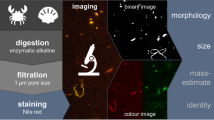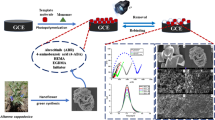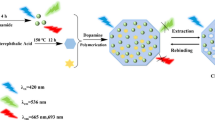Abstract
A nanooptosensor based on the fluorescence quenching of a composite probe was fabricated for the detection of sarafloxacin. The components of the nanocomposite fluorescent probe were a high affinity material of polydopamine polymer (PDA), a selective material of molecularly imprinted polymer (MIP), and optically sensitive quantum dots (QDs). The developed nanocomposite fluorescent probe exhibited excellent selectivity and sensitivity for sarafloxacin. The molecularly imprinted polymer had an imprinting factor (IF) of 8.18 and produced a probe that quenched fluorescence more effectively than a non-imprinted polymer (NIP) probe. The emission intensity of the MIP probe was linearly quenched by sarafloxacin over a range of 0.10 to 15.0 μg L−1 with a determination coefficient (R2) of 0.9966. The developed nanooptosensor had a limit of detection of 0.05 μg L−1. The optosensor detected sarafloxacin in chicken meat samples with recoveries ranging from 82.8 to 99.1% with an RSD below 3%. The found concentrations in spiked samples were compared well with recoveries obtained by HPLC method of detection. This developed nanooptosensor is simple to operate and cost-effective and the analytical procedure is rapid.

Graphical abstract







Similar content being viewed by others
Change history
21 April 2023
A Correction to this paper has been published: https://doi.org/10.1007/s00216-023-04700-z
References
Zhao SJ, Li C, Jiang HY, Li BY, Shen JZ. Simultaneous determination of 7 quinolones residues in animal muscle tissues by high performance liquid chromatography. Chin J Anal Chem. 2007;35:786–90.
Annunziata L, Visciano P, Stramenga A, Colagrande MN, Campana G, Scortichini G, et al. Development and validation of a method for the determination of quinolones in muscle and eggs by liquid chromatography-tandem mass spectrometry. Food Anal Methods. 2016;9:2308–20.
Barrón D, Jiménez-Lozano E, Bailac S, Barbosa J. Determination of difloxacin and sarafloxacin in chicken muscle using solid-phase extraction and capillary electrophoresis. J Chromatogr B. 2002;767:313–9.
Christodoulou EA, Samanidou VF, Papadoyannis IN. Validation of an HPLC-UV method according to the european union decision 2002/657/EC for the simultaneous determination of 10 quinolones in chicken muscle and egg yolk. J Chromatogr B. 2007;859:246–55.
Urraca JL, Castellari M, Barrios CA, Moreno-Bondi MC. Multiresidue analysis of fluoroquinolone antimicrobials in chicken meat by molecularly imprinted solid-phase extraction and high performance liquid chromatography. J Chromatogr A. 2014;1343:1–9.
Yan Z, Zhang Z, Yu Y, Liu Z, Chen J. Chemiluminescence determination of potassium bromate in flour based on flow injection analysis. Food Chem. 2016;190:20–4.
Xia Q, Yang Y, Liu M. Aluminium sensitized spectrofluorimetric determination of fluoroquinolones in milk samples coupled with salting-out assisted liquid-liquid ultrasonic extraction. Spectrochim Acta A. 2012;96:358–64.
Sorouraddin MH, Iranifam M, Imani-Nabiyyi A. Study of the enhancement of a new chemiluminescence reaction and its application to determination of beta-lactam antibiotics. Luminescence. 2009;24:102–7.
Resch-Genger U, Grabolle M, Cavaliere-Jaricot S, Nitschke R, Nann T. Quantum dots versus organic dyes as fluorescent labels. Nat Methods. 2008;5:763–75.
Bunkoed O, Kanatharana P. Mercaptopropionic acid-capped CdTe quantum dots as fluorescence probe for the determination of salicylic acid in pharmaceutical products. Luminescence. 2015;30:1083–9.
Montoro Bustos AR, Garcia-Cortes M, Gonzalez-Iglesias H, Ruiz Encinar J, Costa-Fernandez JM, Coca-Prados M, et al. Sensitive targeted multiple protein quantification based on elemental detection of quantum dots. Anal Chim Acta. 2015;879:77–84.
Nurerk P, Kanatharana P, Bunkoed O. A selective determination of copper ions in water samples based on the fluorescence quenching of thiol-capped CdTe quantum dots. Luminescence. 2016;31:515–22.
Rocha TL, Saboia-Morais SM, Bebianno MJ. Histopathological assessment and inflammatory response in the digestive gland of marine mussel Mytilus galloprovincialis exposed to cadmium-based quantum dots. Aquat Toxicol. 2016;177:306–15.
Wei X, Hao T, Xu Y, Lu K, Li H, Yan Y, et al. Facile polymerizable surfactant inspired synthesis of fluorescent molecularly imprinted composite sensor via aqueous CdTe quantum dots for highly selective detection of λ-cyhalothrin. Sensors Actuators B Chem. 2016;224:315–24.
Zhou J, Liu Y, Tang J, Tang W. Surface ligands engineering of semiconductor quantum dots for chemosensory and biological applications. Mater Today. 2017;20:360–76.
Huy BT, Kumar AP, Seo MH, Kim JD, Lee YI. Controllable synthesis of thiol-capped CdTe nanoparticles for optical sensing of triethylenetetramine dihydrochloride. J Nanosci Nanotechnol. 2014;14:7662–7.
Tan L, Guo M, Tan J, Geng Y, Huang S, Tang Y, et al. Development of high-luminescence perovskite quantum dots coated with molecularly imprinted polymers for pesticide detection by slowly hydrolysing the organosilicon monomers in situ. Sensors Actuators B Chem. 2019;291:226–34.
Belbruno JJ. Molecularly imprinted polymers. Chem Rev. 2019;119:94–119.
Pan J, Chen W, Ma Y, Pan G. Molecularly imprinted polymers as receptormimics for selective cell recognition. Chem Soc Rev. 2018;47:5574–87.
Chao MR, Hu CW, Chen JL. Glass substrates crosslinked with tetracycline-imprinted polymeric silicate and CdTe quantum dots as fluorescent sensors. Anal Chim Acta. 2016;925:61–9.
Yin Y, Li H, Zhu L, Guo T, Li X, Xing W, et al. A durable mesh decorated with polydopamine/graphene oxide for highly efficient oil/water mixture separation. Appl Surf Sci. 2019;479:351–9.
Li Y, Zhao R, Chao S, Sun B, Wang C, Li X. Polydopamine coating assisted synthesis of MnO2 loaded inorganic/organic composite electrospun fiber adsorbent for efficient removal of Pb2+ from water. Chem Eng J. 2018;344:277–89.
Zhai Y, Whitten JJ, Zetterlund PB, Granville AM. Synthesis of hollow polydopamine nanoparticles using miniemulsion templating. Polym J. 2016;105:276–83.
Sheng W, Li W, Zhang G, Tong Y, Liu Z, Jia X. Study on the UV-shielding and controlled-release properties of a polydopamine coating for avermectin. New J Chem. 2015;4:2752–7.
Zhi K, Wang L, Zhang Y, Jiang Y, Zhang L, Yasin A. Influence of size and shape of silica supports on the sol–gel surface molecularly imprinted polymers for selective adsorption of gossypol. Materials. 2018;11:777.
Ensafi AA, Nasr-Esfahani P, Rezaei B. Synthesis of molecularly imprinted polymer on carbon quantum dots as an optical sensor for selective fluorescent determination of promethazine hydrochloride. Sensors Actuators B Chem. 2018;257:889–96.
Ren X, Chen L. Preparation of molecularly imprinted polymer coated quantum dots to detect nicosulfuron in water samples. Anal Bioanal Chem. 2015;407:8087–95.
Zhang L, Chen L. Visual detection of melamine by using a ratiometric fluorescent probe consisting of a red emitting CdTe core and a green emitting CdTe shell coated with a molecularly imprinted polymer. Microchim Acta. 2018;185:135–43.
Miao Y, Sun X, Lv J, Yan G. Phosphorescent mesoporous surface imprinting microspheres: preparation and application for transferrin recognition from biological fluids. ACS Appl Mater Interfaces. 2019;11:2264–72.
Yu H, Tao Y, Chen D, Pan Y, Liu Z, Wang Y, et al. Simultaneous determination of fluoroquinolones in foods of animal origin by a high performance liquid chromatography and a liquid chromatography tandem mass spectrometry with accelerated solvent extraction. J Chromatogr B. 2012;885–6:150–9.
Rodriguez Caceres MI, Guiberteau Cabanillas A, Galeano Diaz T, Martinez Canas MA. Simultaneous determination of quinolones for veterinary use by high-performance liquid chromatography with electrochemical detection. J Chromatogr B. 2010;878:398–402.
Roudaut B, Yorke JC. High-performance liquid chromatographic method with fluorescence detection for the screening and quantification of oxolinic acid, flumequine and sarafloxacin in fish. J Chromatogr B. 2002;780:481–5.
Cohen E, Maxwell RJ, Donoghue DJ. Automated multi-residue isolation of fluoroquinolone antimicrobials from fortified and incurred chicken liver using on-line microdialysis and high-performance liquid chromatography with programmable fluorescence detection. J Chromatogr B. 1999;724:137–45.
Monteiro SH, Francisco JG, Campion TF, Pimpinato RF, Moura Andrade GCR, Garcia F, et al. Multiresidue antimicrobial determination in Nile tilapia (Oreochromis niloticus) cage farming by liquid chromatography tandem mass spectrometry. Aquaculture. 2015;447:37–43.
Samanidou V, Evaggelopoulou E, Trotzmuller M, Guo X, Lankmayr E. Multi-residue determination of seven quinolones antibiotics in gilthead seabream using liquid chromatography-tandem mass spectrometry. J Chromatogr A. 2008;1203:115–23.
Moreno-Gonzalez D, Lara FJ, Gamiz-Gracia L, Garcia-Campana AM. Molecularly imprinted polymer as in-line concentrator in capillary electrophoresis coupled with mass spectrometry for the determination of quinolones in bovine milk samples. J Chromatogr A. 2014;1360:1–8.
Lombardo-Agui M, Garcia-Campana AM, Gamiz-Gracia L, Cruces Blanco C. Laser induced fluorescence coupled to capillary electrophoresis for the determination of fluoroquinolones in foods of animal origin using molecularly imprinted polymers. J Chromatogr A. 2010;1217:2237–42.
Evaggelopoulou EN, Samanidou VF. HPLC confirmatory method development for the determination of seven quinolones in salmon tissue (Salmo salar L.) validated according to the European Union Decision 2002/657/EC. Food Chem. 2013;136:479–84.
Acknowledgments
The authors thank Mr. Thomas Duncan Coyne for English proofreading.
Funding
The project was supported by Prince of Songkla University (Grant No. SCI6202115N-0), the Thailand Research Fund (TRF), Office of the Higher Education Commission and Center of Excellence for Innovation in Chemistry (PERCH-CIC).
Author information
Authors and Affiliations
Corresponding author
Ethics declarations
Conflict of interest
The authors declare that they have no conflict of interest.
Additional information
Publisher’s note
Springer Nature remains neutral with regard to jurisdictional claims in published maps and institutional affiliations.
A.Electronic supplementary material
ESM 1
(PDF 1074 kb)
Rights and permissions
Springer Nature or its licensor (e.g. a society or other partner) holds exclusive rights to this article under a publishing agreement with the author(s) or other rightsholder(s); author self-archiving of the accepted manuscript version of this article is solely governed by the terms of such publishing agreement and applicable law.
About this article
Cite this article
Chaowana, R., Bunkoed, O. A nanocomposite probe of polydopamine/molecularly imprinted polymer/quantum dots for trace sarafloxacin detection in chicken meat. Anal Bioanal Chem 411, 6081–6090 (2019). https://doi.org/10.1007/s00216-019-01993-x
Received:
Revised:
Accepted:
Published:
Issue Date:
DOI: https://doi.org/10.1007/s00216-019-01993-x




